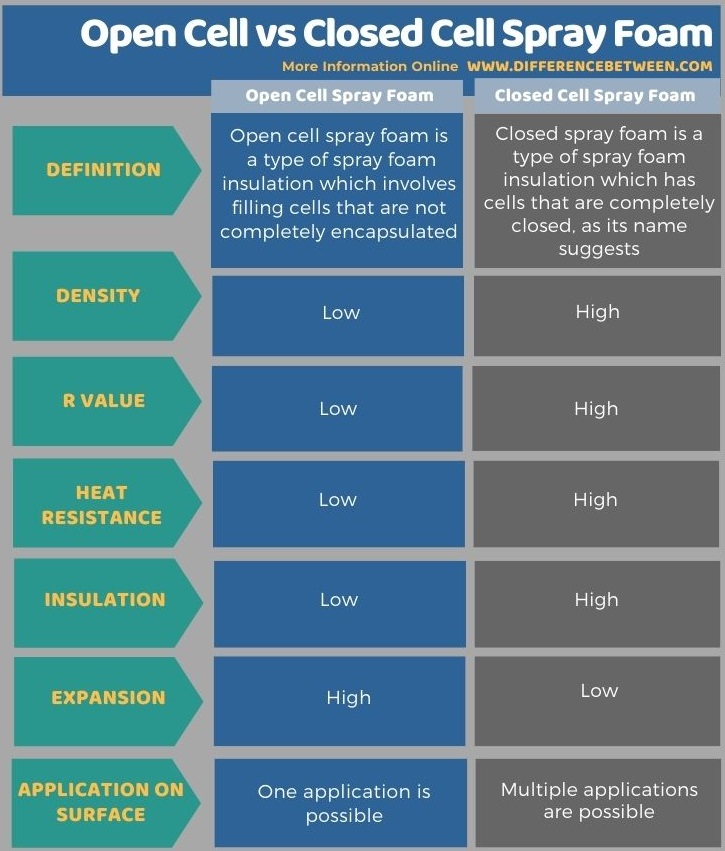Difference Between Open Cell and Closed Cell Spray Foam
The key difference between open cell and closed cell spray foam is that open cell spray foam has a low density whereas closed cell spray foam has a high density.
Spray foam is a type of chemical product that is developed from two materials: isocyanate and polyol resin. These two components react when mixed with each other expanding up to about 50 times its liquid volume after sprayed on a surface. Therefore, this material is useful in speciality packing because it takes the shape of the product that we are going to pack and produces a high thermal insulating value with virtually no air infiltration.
CONTENT
1. Overview and Key Difference
2. What is Open Cell Spray Foam
3. What is Closed Cell Spray Foam
4. Side by Side Comparison – Open Cell vs Closed Cell Spray Foam in Tabular Form
5. Summary
What is Open Cell Spray Foam?
Open cell spray foam is a type of spray foam insulation, which is filling of cells that are not completely encapsulated. This spray foam has a low density. This means the cells of this material are deliberately left open. Therefore, the foam of this material is very soft and more flexible. The density of an open cell spray foam is about 5 pounds per cubic foot.

R-value of a spray foam is the resistance of foam to heat flow or the ability to insulate. Generally, open cell spray foams have a comparatively low R value; this means the insulation provided by open cell spray foam is comparatively low. Furthermore, the expansion of this spray foam type is high, so only one application on a surface is possible.
What is Closed Cell Spray Foam?
Closed spray foam is a type of spray foam insulation which has cells that are completely closed, as its name suggests. This spray foam type has a high density. In this material, the cells are pressed together. Therefore, air and moisture are unable to enter inside the foam. This makes the closed cell spray foam much more rigid and stable than the open cell foam.

The density of a closed cell spray foam is about 17.5 pounds per cubic foot. R-value or the ability to insulate is high compared to open cell spray foam. Therefore, the insulation provided by closed cell spray foam is considerably high. Moreover, closed cell spray foam has a low degree of expansion which makes it possible to apply multiple applications on a surface.
What is the Difference Between Open Cell and Closed Cell Spray Foam?
There are two types of spray foam as open cell spray foam and closed cell spray foam. The key difference between open cell and closed cell spray foam is that open cell spray foam has a low density, whereas closed cell spray foam has a high density. Most of the open cell spray foam types have a density of 5 pounds per cubic foot, but the density of closed cell spray foam is about 17.5 pounds per cubic foot.
Below infographic shows the differences between open cell and closed cell spray foam in tabular form for side by side comparison.

Summary – Open Cell vs Closed Cell Spray Foam
A spray foam is a type of chemical product that is developed from two materials, isocyanate and polyol resin. There are two types of spray foam insulation as open cell spray foam and closed cell spray foam. The key difference between open cell and closed cell spray foam is that open cell spray foam has a low density, whereas closed cell spray foam has a high density.
Reference:
1. “Open Cell vs Closed Cell Foam: Which Should I Choose?” Tiger Foam Insulation, 28 June 2018, Available here.
Image Courtesy:
1. “Found foam insulation” By Kencf0618 – Own work (CC BY-SA 3.0) via Commons Wikimedia
2. “Chicago Closed Cell Spray Foam Insulation In Wall” By Chicagosprayfoam – Own work (CC BY-SA 3.0) via Commons Wikimedia
ncG1vNJzZmivp6x7pbXFn5yrnZ6YsqOx07CcnqZemLyue8OinZ%2Bdopq7pLGMm5ytr5Wau267z56lZpuVoblurc2dZJykn6iypXnCnqOlZaOlv6LFjJ%2BmmqVf